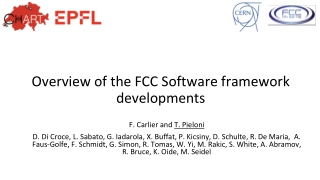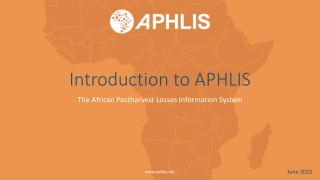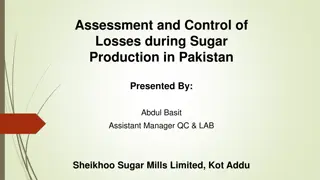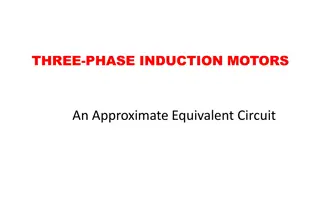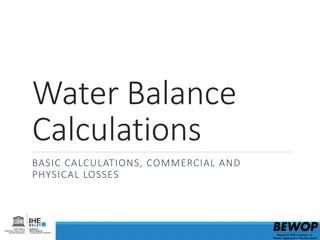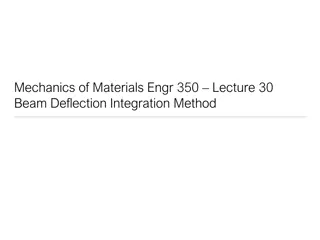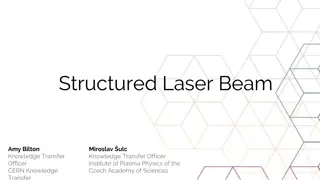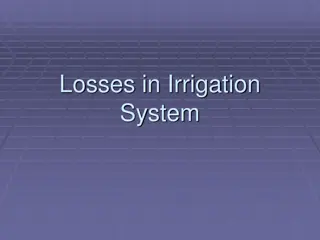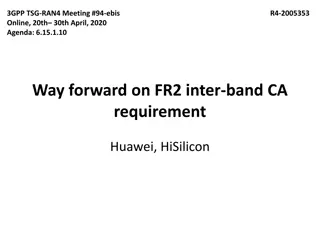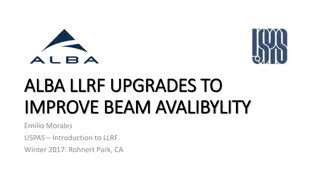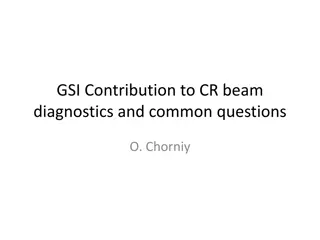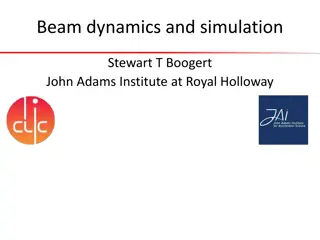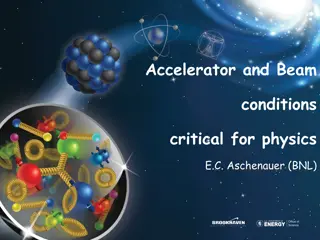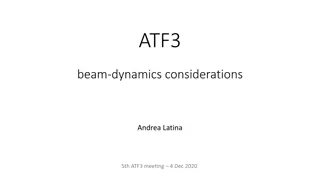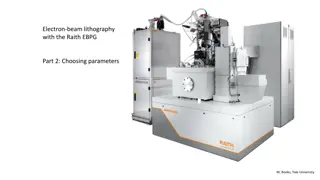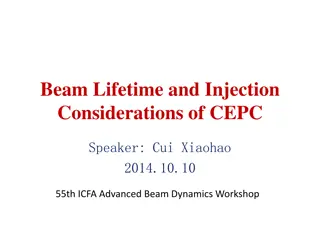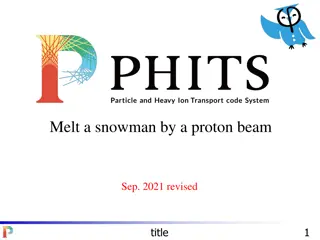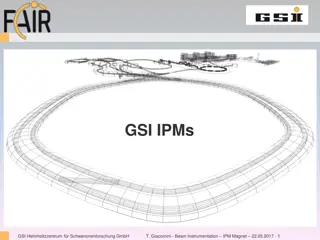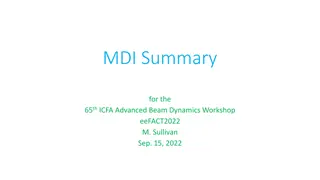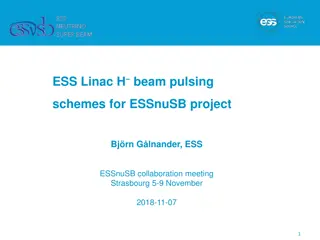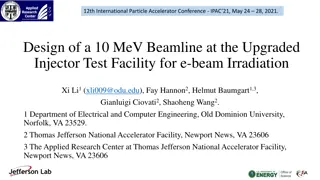Overview of the FCC Software framework developments
Overview provides information on the developments of the FCC Software Framework (SF) project, including modular software design and simulation capabilities for the Future Circular Lepton Collider (FCC-ee). It covers topics such as beam-beam interactions, lattice descriptions, beam lifetime studies,
1 views • 24 slides
Introduction to APHLIS
APHLIS, the African Postharvest Losses Information System, highlights the significant postharvest losses in Africa, occurring at various points in the value chain from harvesting to market storage. These losses, ranging from 30-50% of crop production, have detrimental consequences such as food insec
1 views • 30 slides
Assessment and Control of Sugar Production Losses in Pakistan
Maximizing sucrose recovery in sugar production is crucial for optimizing operational efficiency and profitability. This study focuses on identifying and managing operational losses within the sugar production process in Pakistan, categorizing losses as determined (easily measurable) and undetermine
2 views • 16 slides
Power Analysis and Efficiency Calculations for Three-Phase Induction Motors
The provided content discusses the power relations and efficiency calculations for two examples of three-phase induction motors. It covers topics such as air gap power, power converted, output power, stator copper losses, rotor copper losses, core losses, stray losses, and efficiency calculations. D
0 views • 16 slides
Understanding the Conjugate Beam Method in Structural Analysis
The Conjugate Beam Method is a powerful technique in structural engineering, derived from moment-area theorems and statical procedures. By applying an equivalent load magnitude to the beam, the method allows for the analysis of deflections and rotations in a more straightforward manner. This article
0 views • 11 slides
Water Balance Calculations and Losses Analysis
Water balance calculations involve assessing commercial and physical losses in a water distribution system. The process includes basic calculations, evaluation of commercial losses such as metering inaccuracies and non-revenue water, as well as physical losses like leakage in transmission lines. Add
0 views • 21 slides
Beam Deflection and Integration Method in Mechanics of Materials
Understanding beam deflection through integration method involves analyzing relationships between moment, deflection, slope, and shear in a beam structure. By integrating the moment equation under certain assumptions and boundary conditions, engineers can determine deflections and solve for constant
0 views • 12 slides
Innovative Structured Laser Beam Technology for Improved Beam Propagation
An overview of a novel structured laser beam (SLB) system designed for long-distance propagation with low divergence and a small central spot size. This cost-effective method allows for easy adjustment of beam parameters and offers advantages such as self-reconstruction after obstacles, compact spot
0 views • 9 slides
Understanding Losses in Irrigation Systems: Measurement Methods and Techniques
Losses in irrigation systems, including seepage and evaporation, are major concerns impacting water conservation. This article discusses historical estimates of losses, types of losses (seepage and evaporation), methods used to measure losses (direct and indirect), and detailed information on seepag
6 views • 29 slides
Analysis of Multipole Error Effects on Beam Dynamics in CEPC Accelerator
The content discusses the impact of multipole errors on the beam dynamics at the CEPC Accelerator, focusing on sources of error, measurements, and potential effects on the beam. The analysis includes different types of multipole errors, their sources, and the resulting changes in tune and emittance
4 views • 11 slides
Correlated Head-Tail Instability in Beam-Beam Collisions
The study discusses the impact of the cross wake force and correlated head-tail instability in collisions with a large crossing angle. It delves into the mechanism of beam-beam instability, cross wake force induction, mode coupling, and particle tracking simulations. Design parameters and instabilit
0 views • 34 slides
Analysis of Beam Commissioning and Tune Evolution in 2015
This study analyzes the tune variation during beam commissioning in 2015 at the Large Hadron Collider. It includes comparisons of beam fills, bare tune analysis, evolution, and differences between beams 1 and 2. The research delves into the behavior of tune parameters, energy models, and the accurac
0 views • 9 slides
Agreements on FR2 Inter-Band Carrier Aggregation Requirements
Agreements have been reached on the RRM requirements and scaling factors for FR2 inter-band Carrier Aggregation, focusing on common beam and independent beam management. Discussions include alignment with Release 16 specifications, scenarios, and RF architectures. Interruption requirements for diffe
0 views • 8 slides
Beam Energy Calibration with Compton Scattering Method
The CEPC beam energy calibration with Compton scattering method led by Yongsheng Huang and the CEPC energy calibration working group involves collaborations with various institutions and organizations. The project includes detailed physics requirements, system designs, and implementation plans for b
0 views • 14 slides
Enhancing Beam Availability with ALBA LLRF Upgrades
ALBA LLRF upgrades aim to improve beam availability by implementing auto-recovery processes and feed-forward loops for RF trip compensation. The upgrades involve detuning cavities, adjusting amplitudes and phases, and enabling tuning loops to ensure smooth power delivery to the beam. Despite challen
0 views • 10 slides
GSI Contribution to CR Beam Diagnostics and Future Contracts
Contribution of GSI to CR beam diagnostics includes discussions on diagnostic devices, component status, working questions, and future contracts. Future plans involve the procurement of various devices and components required for beam diagnostics. Known demands for 400 mm diagnostics devices are out
0 views • 16 slides
Advancements in Beam Dynamics and Simulation at John Adams Institute
Explore the latest research highlights in beam dynamics and simulation conducted by Stewart T. Boogert at the John Adams Institute in collaboration with Royal Holloway. Learn about the groundbreaking work in wakefield measurement, achieving a beam size of 65 nm, development of beam delivery simulati
0 views • 15 slides
Understanding Beam Conditions and Effects in Particle Physics Experiments
Critical accelerator and beam conditions for E.C. Aschenauer's physics research at BNL are discussed, including effects on the main detector, consequences of crossing angle adjustments, important particle beam parameters, and the rotation of the ESR reference plane. Detailed information on beam dive
0 views • 8 slides
Critical Issues in CLIC Drive Beam by Working Group 6 at LCWS11
Issues identified in the CLIC Drive Beam project include RF stability and reliability, beam current stability, RF deflectors in combiner rings, synchrotron radiation power, beam dynamics, operability concerns, machine protection, and beam synchronization challenges. Key areas requiring attention inc
0 views • 5 slides
Recommendations for Advancing Beam Physics and Accelerator Education
The exploration of new physics demands future accelerators beyond 1 TeV lepton colliders and 100 TeV hadron colliders, requiring luminosity in a specific range. Various challenges, including reaching quantum limits, face conventional RF-based beams. The pursuit of disruptive acceleration technologie
0 views • 7 slides
Beam-beam Effects in Future Hadron Colliders Workshop
Explore the beam-beam effects in the SPPC and future hadron colliders, presented at the International Workshop on High Energy Circular Electron-Positron Colliders. The workshop covers weak-strong beam-beam simulations, collision models, and parameter values for the SPPC. Detailed discussions on the
0 views • 32 slides
Challenges in ATF3 Beam Dynamics Considerations by Andrea Latina
The final focus system in a linear collider, such as ATF3, is challenging due to imperfections like wakefields, magnets misalignment, and beam jitter. The design goals at ATF2 were ambitious but faced difficulties in achieving the desired beam size. Imperfections like dipole/quadrupole misalignment,
0 views • 7 slides
Analysis of Beam Tracking in IEEE 802.11-19/0007r0 Document
The document "January 2019.doc: IEEE 802.11-19/0007r0" discusses the necessity of beam tracking in the 11md draft. It explores whether beam tracking should be mandatory or optional and provides insights into DMG beam tracking procedures for both TX and RX in wireless communication. The document emph
0 views • 11 slides
Revolutionizing Oral Care with Beam Connected Toothbrush and Insurance Plan
Beam Technologies offers the Beam Brush, a smart toothbrush that integrates with a dental insurance plan to promote preventative oral care, reduce costs, and provide valuable insights on oral health. The Beam Brush and accompanying app track and reward good oral hygiene habits, detect oral diseases,
0 views • 5 slides
Choosing Parameters for Electron-Beam Lithography with the Raith EBPG
In the process of electron-beam lithography with the Raith EBPG, selecting parameters such as resist type, resist thickness, spot size, dose range, resist sensitivity, and beam step size is crucial for achieving precise patterns. Factors like the substrate, developer, and pattern transfer technique
0 views • 9 slides
Understanding Beam Lifetime and Injection Considerations at CEPC
Delve into the intricacies of beam lifetime and injection considerations at the CEPC, exploring topics such as beam-gas scattering, quantum lifetime, Touschek lifetime, and injection modes. Discover the crucial factors affecting beam stability and injection efficiency in particle accelerators.
0 views • 20 slides
Proton Beam Simulation for Melting Snowman in Gundam Analysis
Conducting a proton beam simulation to analyze the feasibility of the beam rifle in Gundam by melting a snowman. The exercise involves setting up geometry, defining parameters, sources, materials, and cells, and calculating energy deposition. Follow the flow chart to determine beam current and power
0 views • 19 slides
Overview of Beam Instrumentation at GSI
Beam instrumentation at GSI, specifically focusing on IPMs, plays a crucial role in managing various aspects of accelerator operations. The images and descriptions provided highlight the use of IPMs for setting up different ion sorts, beam width monitoring, cooling and injection optimization, and fa
0 views • 28 slides
Advanced Beam Diagnostics and Control Systems in Beam Physics
Cutting-edge detector technologies like KAPTURE and KALYPSO are revolutionizing beam diagnostics with ultra-fast Terahertz detectors and advanced line-camera systems. The POF III and POF IV projects focus on extreme beam control and diagnostics, aiming to probe femto-scale dynamics of relativistic p
0 views • 8 slides
Overview of Electron/Positron Injector Linac Upgrades at KEK
The recent status of the Electron/Positron Injector Linac at KEK, presented by Kazuro Furukawa, highlights the mission to achieve 40 times higher luminosity in the SuperKEKB collider. The upgrades include low emittance, low energy spread injection beams with higher beam current, new high-current pho
0 views • 23 slides
Ion Beam Intensity Enhancement Through Electron Heating in Collider Experiments
The study discusses electron heating of ions in collider experiments at the Collider V. ParkhomchukBINP facility in Novosibirsk. It explores the effects of electron cooling on ion beams, ion beam oscillations, losses, and ion beam intensity enhancement. Various factors such as ion charge, classical
0 views • 9 slides
Highlights of the 65th ICFA Advanced Beam Dynamics Workshop
The 65th ICFA Advanced Beam Dynamics Workshop featured insightful presentations on high currents, luminosity, and beam behaviors. Topics included beam pipe scrubbing, non-gaussian beam tails, and detector backgrounds. Presenters discussed progress in FCCee design, focus magnets, and beampipe concept
0 views • 32 slides
Achieving High Average Beam Polarization in Particle Colliders
Detailed discussion on achieving high average beam polarization in particle colliders like CEPC, focusing on longitudinal polarized colliding beams, beam polarization requirements, basic formulas, and strategies for maintaining beam polarization during physics runs. Emphasis on scenarios involving s
0 views • 16 slides
ESSnuSB Project - Linac Upgrade for Neutrino Beam Generation
Explore the ESSnuSB project's linac upgrade featuring beam pulsing schemes and modifications, aiming to provide an additional 5 MW of beam power for neutrino generation. The upgrade options, pulse structure, beam parameters at 2.5 GeV, and different pulsing schemes are detailed with images and descr
0 views • 10 slides
Electron Lenses in Particle Accelerators: Advancements and Applications
Explore the use of electron lenses in particle accelerators for space-charge compensation, Landau damping, halo collimation, and beam-beam compensation. Learn about their history, applications in Tevatron and RHIC colliders, and current research areas. Electron lenses have shown promise in enhancing
0 views • 44 slides
Update on UE Beam Assumption for RRM Test Cases in 3GPP Meetings
The latest developments in 3GPP meetings regarding UE beam assumption for RRM test cases are outlined. Discussions include the need for UE beam type assumptions, updates to test cases for FR2, and upcoming presentations focusing on specific test cases and beam assumptions per test group. Test purpos
0 views • 9 slides
Overview of Mu2e Slow Extraction Workshop at Fermilab by Vladimir Nagaslaev
This content discusses the Mu2e project at Fermilab, focusing on slow extraction techniques for beam delivery. It covers beam facilities, characteristics of Muon Campus, design requirements, beam losses, new MARS simulations, and losses in the extraction beam line. Details include beam kinetics, spi
0 views • 17 slides
Overview of CAIN Particle Tracking Code for High-Energy Colliders
CAIN is a particle tracking code used for high-energy collider simulations since 1984. Initially named ABEL, it evolved to include beam-laser interactions for gamma-gamma colliders. The code, written in FORTRAN 90, handles beam-beam and external fields, with a structure where all particles are store
0 views • 17 slides
Understanding Set-off of Losses in Income Tax
Set-off of losses in income tax allows taxpayers to reduce their taxable income by offsetting losses from one source against income from another source. This process helps in minimizing tax liability and optimizing tax planning strategies. There are specific rules and exceptions regarding the set-of
0 views • 4 slides
Design of a 10 MeV Beamline for E-beam Irradiation at UITF Wastewater Facility
This paper discusses the design of a 10 MeV beamline at the Upgraded Injector Test Facility for electron beam irradiation, focusing on wastewater treatment for environmental restoration. The use of electron beam irradiation is highlighted as an effective method to remove pollutants like 1,4 dioxane
0 views • 9 slides
